New Hampshire is home to a rich and diverse array of fungi, with over 2000 species of mushrooms identified in the state.
These fungi range from edible gourmet delicacies to inedible look-alikes, and can be found growing in many different habitats. Whether you’re a foraging enthusiast or an amateur mycologist, New Hampshire’s mushrooms have something special to offer.
Common NH mushrooms include polypores, chicken of the woods, chanterelles, morels and purple corts. If you are looking to engage other mushroomers, I recommend the NH Mushroom Hunters group on Facebook. For foraging classes, contact New Hampshire Outdoor Learning Center and New Hampshire Mushroom Company.
List of Common New Hampshire Mushrooms
1. Cinnabar Polypore
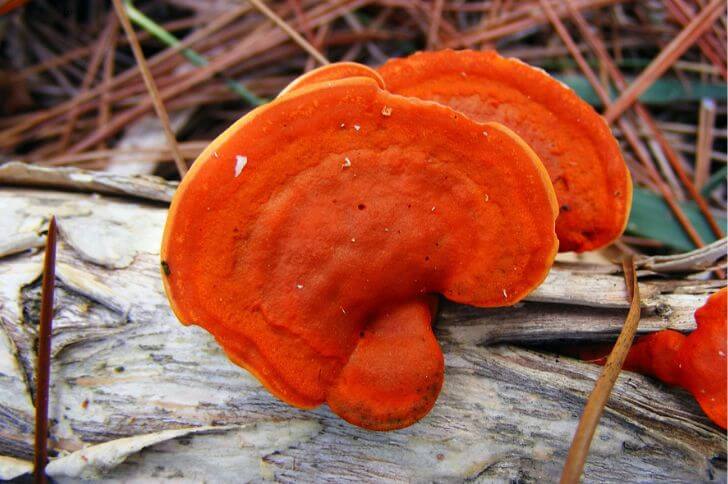
One of the most common bracket fungi of NH is the cinnabar polypore. Often found in ground or singly woods, branches and twigs of dead oaks, these large mushrooms are unmistakable.
This particular mushroom has many identifying features, such as its bright red-orange hue and its bracket-like shape.
The cinnabar polypore has a reddish-orange underside. Its texture is fairly smooth but slightly bumpy or warty on older specimens, while younger specimens may have a velvety feel to them because of the fine hairs on their surface.
The fan-shape cap is 1-5 inches wide. This wild mushroom of New Hampshire is inedible.
2. Chicken of the Woods
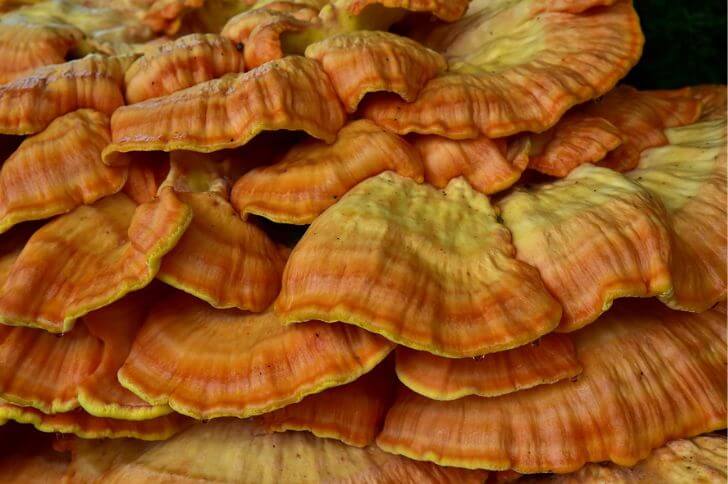
There are different varieties of chicken of the woods. Also called sulphur shelf, two varieties dominate the eastern side.
In New Hampshire, you can get L. sulphureus and L. huroniensis. Both grow on trees, usually oaks, and have a distinctive appearance that can make them easy to identify.
Generally speaking, both have soft, fan-shaped caps which may be anywhere from two inches to 10 inches in diameter depending on their maturity level. Chicken of the Woods color ranges from whitish orange to whitish orange. When sliced, the flesh is the same color as the cap and does not change color.
You can find sulphur shelf mushrooms in New Hampshire from August through November (late summer to fall)
When harvesting, go for younger, succulent fungi. A sharp foraging knife will get the work done. Also instead of regular washing, just wipe with a damp cloth to clean them.
3. Morels
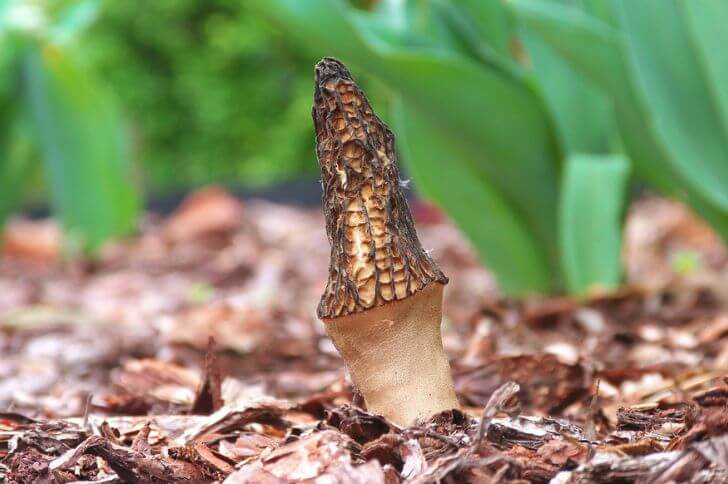
Three common varieties of morels in New Hampshire include:
Blonde morels: One of the rarest New Hampshire mushrooms you should look for from April is the blonde morel. Like other morels, it is pitted on its cap and light brown in color. It is associated with elms, ash, and poplars. What does it taste like? You’ll love its rich earthy taste.
Yellow morels: This is the most common morel on the eastern side. It resembles its blonde cousin above. These New Hampshire morels sport the honeycomb elongated cap and can measure up to 12 inches when mature.
Black morels: Measuring about 6 inches, black morels are smaller than their cousins; yellow morels. They are the darkest in the morchella family with a dark brown to black honeycombed cap.
Where can you find morels in New Hampshire? Check around recently burned areas especially under oaks, tulip poplars, and white ash.
4. False Morels
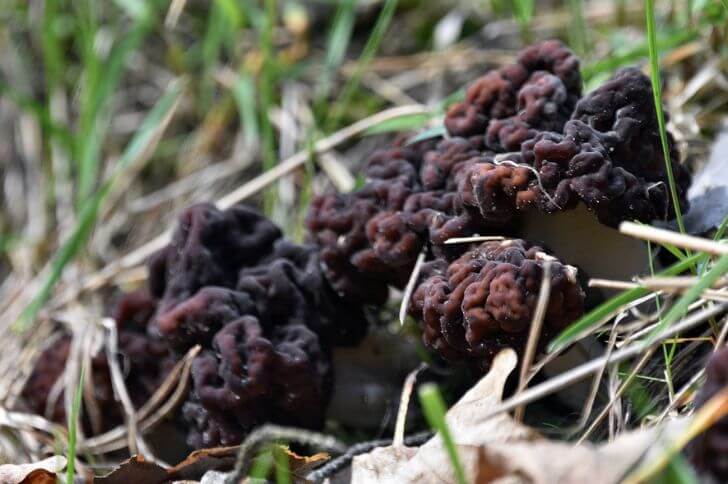
False morels are mushrooms that can be found in different climates and regions around NE. They can be easily mistaken for their edible counterparts above, so proper identification is important for any mushroom hunter looking to find true morels.
The first step in identifying false morels is to recognize their distinct characteristics. These morels typically have a smoother, spongy oval-shaped cap.
The cap is often attached to the stem at the base, whereas a true morel has a distinct separation from the stem at the base. Additionally, when cut open horizontally, false morels are solid and filled with spores while true morels are hollow inside with an empty pocket near the top of the cap.
Finally, false morels have longer stems than true ones; they also tend to be thicker and contain cotton-like fibers throughout.
5. Cortinarius Iodes (Viscid Violet Cort)
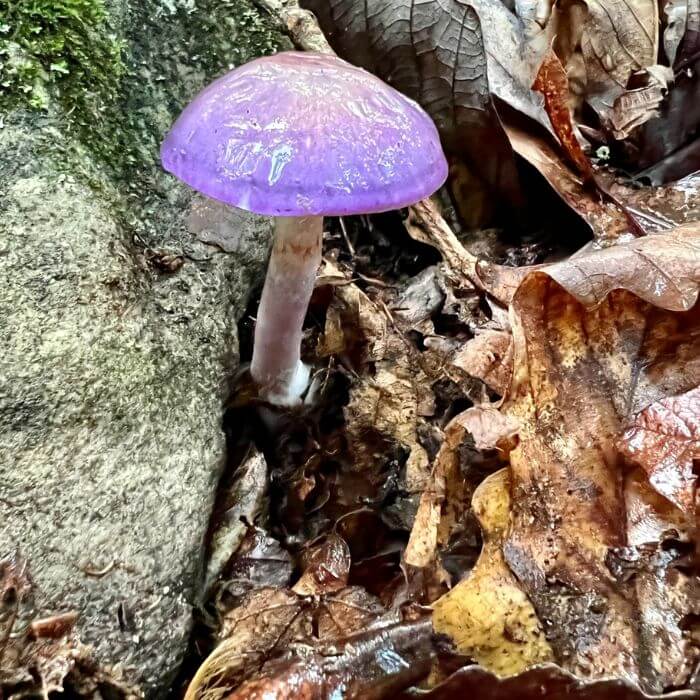
Viscid violet corts are common in eastern North America. They have a mutually beneficial relationship with oaks and grow gregariously in summer and fall.
When viewed from above, the cap of this species ranges from purple to lilac when young and as they mature, you’ll notice yellow spots eventually the whole cap turns grayish. Cap is slimy when wet.
Underneath lilac gills are crowded and they turn brownish in maturity. When cut, the viscid violet cort has whitish to pale purple unchanging flesh. You can learn more about this cort here.
6. Oysters
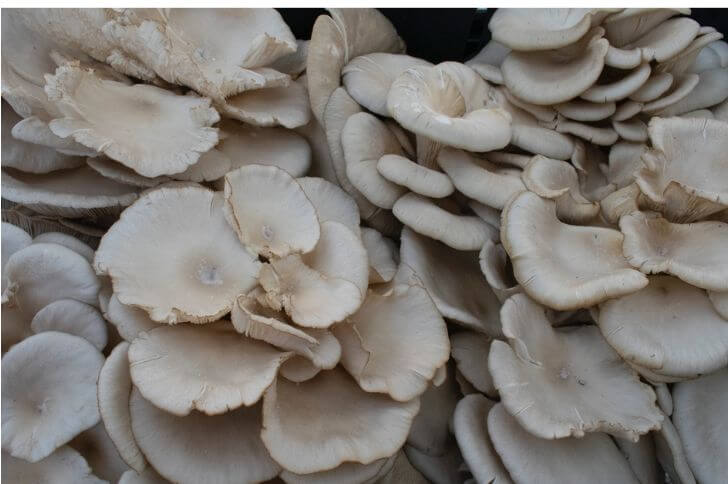
Common oyster mushrooms of New Hampshire include:
Pleurotus levis: Giant panus or pleurotus levis is one of the largest oyster mushrooms. Its cap measures about 3.9-15.7 inches wide. Like other oysters, they appear in summer through fall. They white to cream, turning yellowish in maturity. They have white decurrent gills.
Pleurotus dryinus: Pleurotus dryinus, also called the Veiled Oyster, is a type of edible mushroom that belongs to the family Pleurotaceae.
It is distributed in New Hampshire and can be found growing on dead wood, particularly beech and oak trees. It has a distinct white cap with a hairy surface, and it produces white spores.
Pleurotus populinus: Aspen oyster mushroom is a type of edible New Hampshire mushroom that belongs to the Pleurotus genus.
This species of mushroom is commonly found growing on dead or dying trees, particularly on poplar and aspen trees. The fruiting body is typically broader than the veiled oyster’s and has a more pronounced wave-like edge.
7. Hypholoma Lateritium (Brick Cap)
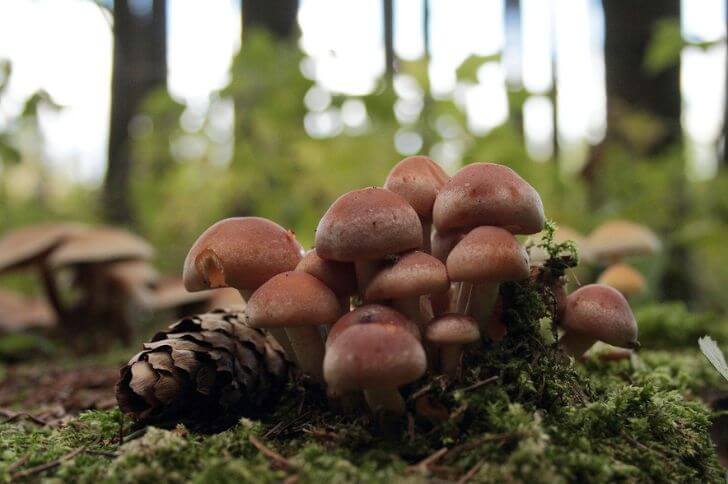
Hypholoma lateritium is a species of agaric fungi that are common in fall. It is often referred to as the Brick Cap mushroom due to its distinct brick red cap.
This mushroom typically grows in large clumps or clusters on decaying wood, especially stumps and logs of deciduous trees such as oak and poplar.
They are fairly common in damp forests, though they may also be found growing on well-rotted sawdust piles near wooden structures.
Brick cap mushrooms have an unmistakable appearance making them easily identifiable. The cap ranges from 1.4-3.9 inches in diameter and is reddish-brown. It has a convex shape when young, then flattens out as it matures with a depressed center surrounded by a slightly lighter margin.
8. Black Trumpet (Craterellus Cornucopioides)
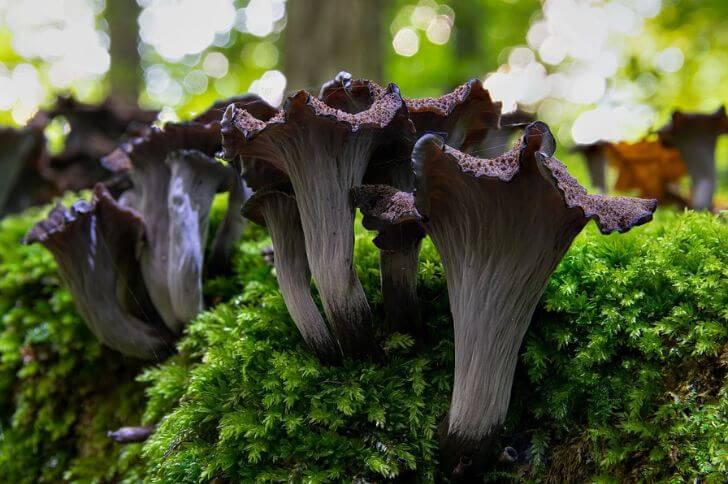
Distantly related to the chanterelles above, black trumpet mushrooms have dark brown to blackish caps, with a hollow stem, making them very easy to identify.
The cap is curved inwards like a trumpet and can grow up to 2.75 inches in diameter. They have an earthy flavor and aroma that makes them popular for cooking.
Black trumpet mushrooms can be found growing on the ground near deciduous trees, especially oaks and beeches.
They typically grow during the late summer months lasting through fall and they are also known to appear after rainfall or in damp areas. To find these wild mushrooms it is important to look under leaf litter on the floor of wooded areas as this is where they thrive best.
9. Orange Peel Fungus (Aleuria aurantia)
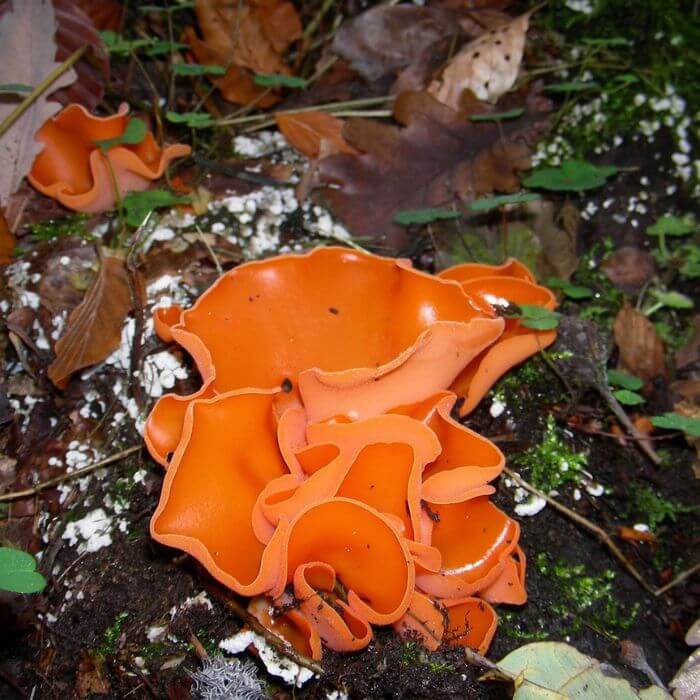
Orange peel fungus mushrooms is a bright NE fungus that grows in clusters on the ground. These bright orange-colored mushrooms are easy to identify due to their distinct shape and color. It has a cup-like shape with a wavy margin and resembles an orange peel, hence its name.
It can vary in size from 0.75 centimeters to 3.9 inches wide. Underneath, this orange New Hampshire mushroom is whitish and when cut reveals yellowish to orange flesh. They don’t have stems.
10. Sparassis Crispa (cauliflower fungus)
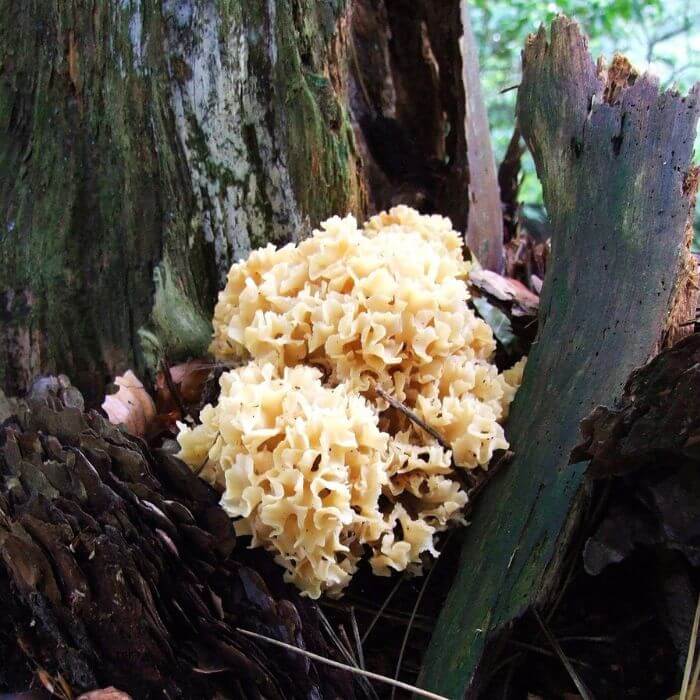
In our list of brain-looking fungi, we looked at cauliflower fungi. It is one of the most common odd looking fungus of New Hampshire. These mushrooms can be identified by their distinct large, brain-like shape. The caps are usually between 5-24 inches in diameter and have a white to yellowish fruiting body depending on age.
Where can you find cauliflower fungus? Check at the base of pine trees. When young, you can harvest and eat them. Be sure to check for debris and bugs.
11. Old Man of the Woods
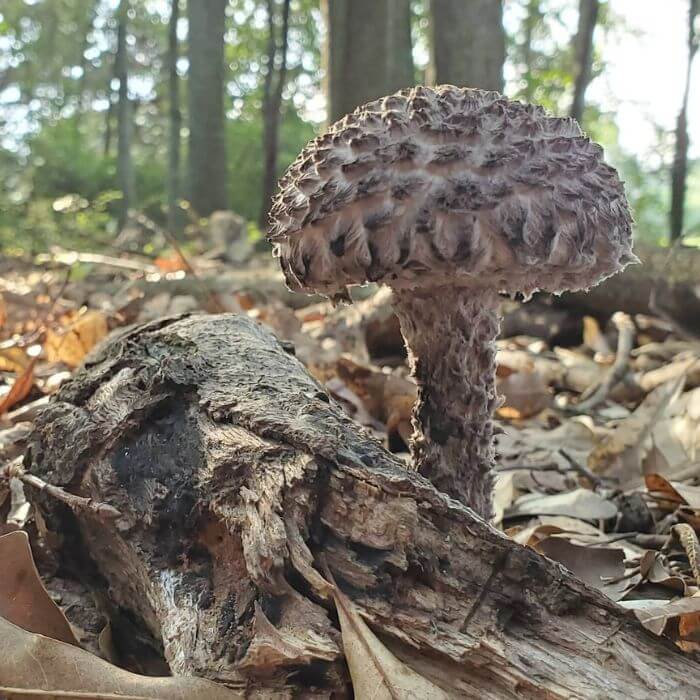
source: scasto4
It’s hard to believe the old man of the woods is a member of the bolete family. It has a very unique look that sets it apart from other boletes.
Its fruiting body grows to 5 inches high. Young specimens are cream with soft scales. Mature specimens are more grayish brown with darker scales. On the underside they have white to black spores.
Are old man of the woods edible? Yes, younger specimens are loved for their earthy flavor. When foraging for this dark-colored fungi, ensure to cut them off at the ground level and place them carefully on your foraging basket. They crumble easily.
This mushroom is best grilled, fried and sauteed.
Also read: Mushroom fairs around North America
12. Lion’s Mane
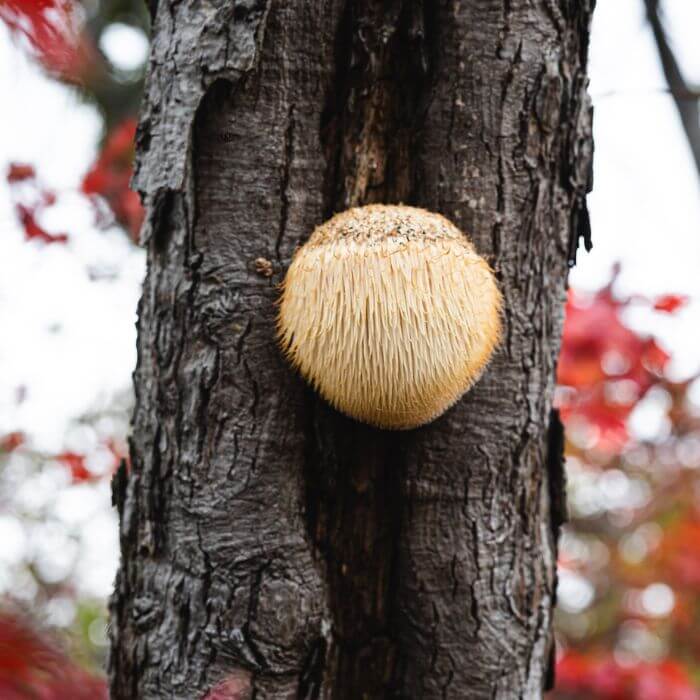
Most New Hampshire mushrooms have lookalikes but the lion’s mare has no true lookalike. Scientific name hericium erinaceus they have long shaggy spines that give them their “mane” like appearance.
They typically grow on dead trees. When young, the spines may appear shorter and more compact than older specimens but should still be easily visible.
13. Jack-o’- lanterns (Omphalotus illudens)
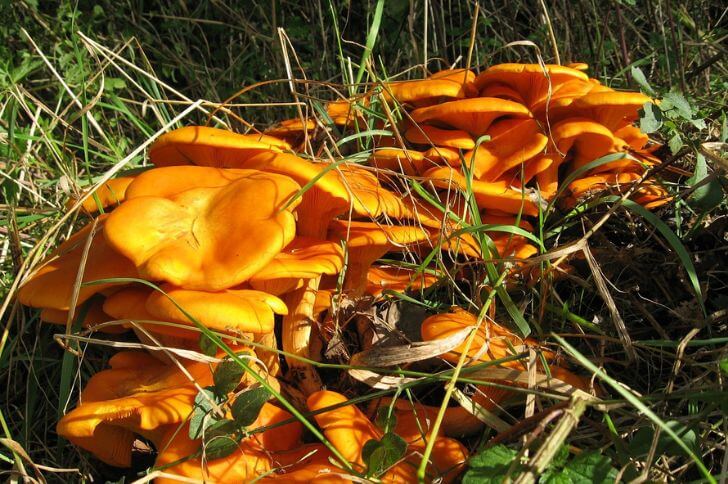
Novice foragers often confuse jack-o’-lanterns with chanterelles. If you are a new forager you can tell them apart by looking at these three distinctive features. One, they are larger than chanterelles, typically about 2-8 inches in diameter.
Two; on the cap underside they have true gills that extend from the edges to down the long stalk. Three: these orange-yellow mushrooms grow in clusters at the base or on stumps of trees. Never on the ground like chanterelles. Jack-o’-lanterns are inedible.
14. Chaga
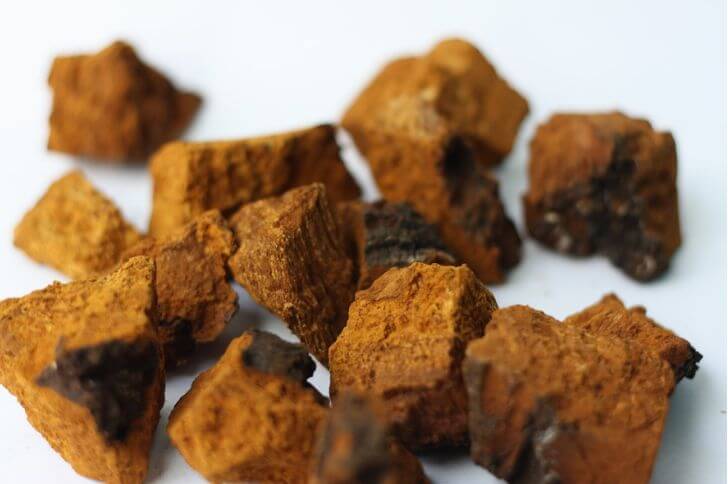
Found primarily in northern climates, these dark, woody fungi can be found growing on birch trees and provide numerous benefits.
Characteristics that help identify Chaga mushrooms include their irregular shape and the presence of a blackened ‘burnt’ exterior caused by their long-term exposure to the elements. Additionally, chaga mushrooms have an interior that is a deep orange color which can be seen when part of the mushroom is removed from its host tree.
Conclusion:
In conclusion,New Hampshire is home to a wide variety of mushrooms that offer lots of culinary benefits.
The majority of them are easy to identify, but it is important to exercise caution when picking mushrooms from the wild.
Some species like lion’s mane and oysters can be grown at home while others such as morels, chanterelles and chaga can only be found in the wild. Happy foraging!
sources:
Hi There,
My name is Jenny. I’m the Chief Editor at Try Green Recipes and besides making yummy and healthy foods for my kids, grandkids, and friends. I’m new to the blogging world but I believe what I have to share is unique and will bring joy to your home. If you are adventurous and want try something tasty, let’s get started.

